
RENÉ CHARTRAND, ILLUSTRATED BY RON VOLSTAD
CANADIAN FORCES IN WORLD WAR II
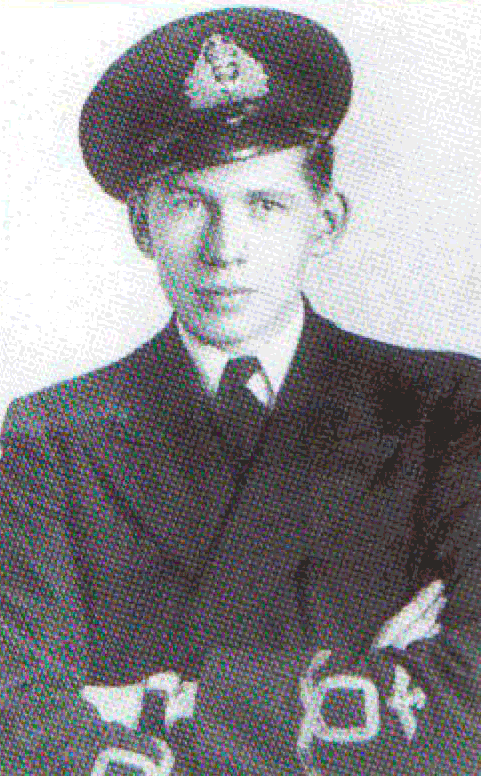
Sub-Lt. Ross M.Wilson was a member of the Royal Canadian Naval Volunteer Reserve who trained to be a carrier pilot in the Fleet Air Arm; he perished in 1942. Just above the 'wavy' RCNVR rank lace can be seen the FAA aircrew badge of a crowned silver fouled anchor and wreath and gold wings. The 'CANADA' shoulder title was apparently not worn by individual Canadian pilots serving on British carriers. (Ross M.A. Wilson Collection)
Canadian military nursing services trace their origins back to the 1885 North-West Rebellion, and the first contingent of Canadian nurses to go overseas was during the South African War. In 1904 a small permanent nursing service was set up within the Royal Canadian Army Medical Corps (RCAMC). Around this small core, nurses from across Canada could be mobilised in times of war according to an agreement between the government and the nursing associations (notably the Canadian Red Gross, St John's Ambulance, and Victorian Order of Nurses). Thus, within months of the outbreak of World War II, thousands of nurses had volunteered into the RCAMC; about 3,656 served in all, more than 2,600 of them overseas, in nearly all theatres of war and in units ranging from field ambulances to general hospitals and convalescent centres. There were also two Canadian hospital ships, the Lady Nelson and the Letitia, which carried 28,000 Allied and 2,700 POW casualties.
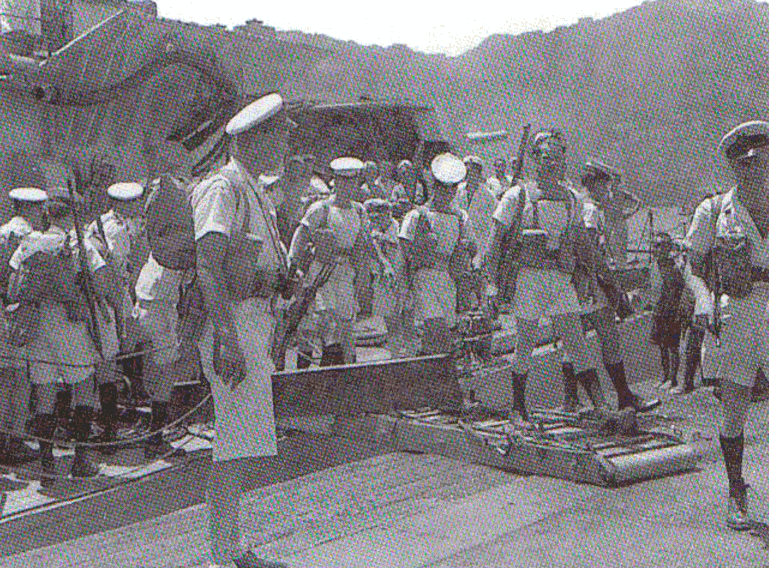
Sailors from HMCS Prince Robert disembarking in Hong Kong on 30 August 1945. They wear the RCN's warm climate dress of white 'fronts' and shorts, with British pattern 1937 khaki web equipment, and carry SMLE rifles, Brens and Stens. Their task was to liberate the survivors of the two Canadian regiments overwhelmed by the Japanese attack in December 1941. At Shamshuipo Camp they found some 1,500 dazed and skeletal prisoners, none of whom would ever entirely recover from their atrocious captivity. Of the Canadian POWs in Japan and Hong Kong, 1,418 survived the ordeal but at least 311 died, of exposure, sickness, exhaustion and ill-treatment - a very marked contrast with the kindness shown to Axis POWs in Canada. (A.M.Sirton, National Archives of Canada, PA114810)
At the outbreak of the war neither the RCN nor the RCAF had nurses. The RCAF Nursing Service was authorised on 28 November 1940 and grew to 481 personnel by 1945, about one in seven of them serving overseas. The RCN began its Nursing Service with three nurses on 4 December 1942, which grew to 343 by the end of the war. In all, Canadian nurses staffed over a hundred major hospitals, admitting some 60,000 Canadians as well as thousands of Allied and enemy wounded soldiers.
All Canadian military nurses had officer status and, in 1942, this was confirmed with equivalent rank designations. In the RCAMC a nursing sister was a lieutenant, a matron a captain, a principal matron a major, and a matron-in-chief a lieutenant-colonel. In the RCAF, a nursing sister was a pilot officer, a principal matron a squadron leader, and the matron-in-chief a wing commander. In the RCN, a nursing sister was a sub-lieutenant and the matron-in-chief a commander.
In hospitals, RCAMC nurses usually wore a sky blue jacket with two rows of brass buttons and white collar and cuffs, a sky blue skirt, a white veil and, when attending patients, a white apron. Rank badges were worn on the shoulder straps. Near the front lines, they wore khaki drill shirts and skirts in Algeria and Sicily in 1943. Towards the end of that year they were issued with Battledress in Italy, and later in Normandy and NW Europe. The RCN and RCAF nurses wore the same type of uniform as Army nurses in hospitals, but the jacket and skirt were navy blue and blue-grey respectively. The naval service had the gold lace rank stripes with maroon distinguishing cloth for nurses, and green for laboratory technicians, dietitians, etc.
Women's auxiliary military organisations
At the outset of the war Canada had no women's services other than nurses, but there had been precedents during the Great War. Spontaneously, thousands of women organised themselves in various unofficial volunteer organisations. As early as 1940, an estimated 17,000 women volunteers had enrolled in various groups, doing administrative and secretarial work, catering, signals and even some mechanical work, as well as attending weekly drill parades. They were often instructed in first aid by staff from the Canadian Red Cross, St John's Ambulance and Victorian Order of Nurses. Their aim was to fill non-combatant jobs to allow men to join the forces.
The various groups often purchased their own uniforms. A favourite of the Toronto groups was the double-breasted light tan trench coat, worn with khaki peaked caps and black mid-calf boots by some, with field service caps and shoes by others. .Another Toronto group had khaki field caps, a jacket whose cut was based on BD but with small buttons, shirt and tie, a skirt and shoes. The Women's Volunteer Reserve Corps, a Quebec unit about 500 strong, wore an air force blue-grey peaked cap, tunic and skirt.
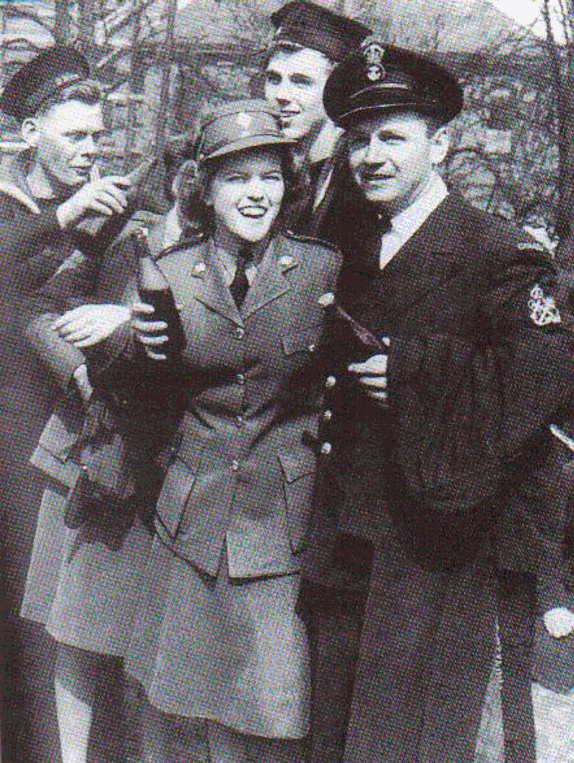
RCN sailors and a Petty Officer celebrating VE-Day with some CWACs on 8 May 1945 in Halifax, Nova Scotia; of Plates G and H. The Petty Officer (right) is distinguished by the peaked cap with crowned anchor badge without a wreath, worn with a double-breasted 'monkey jacket' with gold crown and crossed anchors on his upper left sleeve, white shirt and black tie. Note the CWAC's well-cut khaki tunic with one breast pocket, dark red-brown shoulder straps, and the diamond-shaped collar and cap badges.
After years of restrictions young people in uniform wanted to celebrate, but in Halifax the authorities had made no provision for victory celebrations. Finding all entertainment and liquor outlets closed, thousands of servicemen and women broke into stores and Keith's Brewery, causing the worst disorders in the city's history. A government commission of enquiry blamed the rigid attitudes of senior naval authorities. (National Archives of Canada, C79574)
Appeals were made to the government to recognise and harness all this good will; and finally, from July 1941, a Women's Auxiliary to the Armed Forces of Canada was authorised. The RCAF was first off the mark and immediately raised its Canadian Women's Auxiliary Air Force on 2 July 1941 - the first women's military service to be authorised in North America. It was renamed the Royal Canadian Air Force (Women's Division) on 3 February 1942. It was patterned after the British Women's Auxiliary Air Force and adopted its rank structure, customs and uniforms, but differed in one fundamental feature: it was from the start an integral part of the RCAF and subject to the same code of discipline. Over 17,000 women joined eventually, performing some 70 trades - mostly in Canada, with some in Newfoundland and a few in the USA. From September 1942 a first contingent arrived in Britain; eventually reaching a figure of some 2,000 women, they served mostly at the RCAF Overseas HQ and with 6 Group of RAF Bomber Command. Uniform See Plate H.
On 13 August 1941 the Canadian Women's Army Corps (CWAC) was authorised as an auxiliary of the Army. Some 3,000 women from the volunteer organisations promptly joined and, from 1 September, reported for duty in various locations in Canada. Over the years the CWAC grew to over 21,000 women employed in over 50 trades. Most served in Canada, but many served in the USA and Newfoundland, as well as over 2,000 in the UK, Italy and NW Europe. Uniform See Plate H.

November 1943: Lt.Cdr. Frederick Clairmonte, RCNVR, and his bride Sister Eileen Davidson, with a bridesmaid in the background, both of them in the uniform of the RCN Nursing Service - blue, with gold buttons and gold rank lace on the shoulder boards, white veil, collar and cuffs. (National Archives of Canada, C5859)
The Women's Royal Canadian Naval Service (WRCNS) was organised from 23 July 1942, by three senior officers of the British Women's Royal Naval Service (WRNS) detached for the purpose following a request of the Canadian government. Within a year they had enlisted over 3,000 Canadian women, and the WRCNS eventually numbered over 4,300. The WRCNS was a part of the RCN; its members were subject to the same code of discipline and its training centre, HMCS Conestoga at Gait, Ontario, was commissioned as a training ship. Until June 1943 rank structure was as in the WRNS, but thereafter the WRCNS used naval rank, its officers holding King's Commissions. WRCNS personnel served in over 40 naval bases and establishments in Canada, Newfoundland, New York and Washington in the USA; some were also posted to England and to Londonderry, Northern Ireland. Uniform See Plate II. (See also Brayley, MAA 357, Select Bibliography, for further details of all women's services.)
During World War II, Newfoundland was still 'Britain's oldest colony' and not yet part of Canada (it joined Canada as the tenth province in 1949). However, its wartime defences were closely linked with those of Canada and many Canadian servicemen were posted there. In 1939 there were no military forces or reserves in Newfoundland, which did not have the resources to raise its own. An arrangement was made with Britain whereby Newfoundlanders who joined could serve in the same British units. In 1940 the 59th (Newfoundland) Heavy Regiment, Royal Artillery, and the 166th (Newfoundland) Field Regiment, RA, were raised; the 59th served in North Africa and Italy with the 8th Army, the 166th in NW Europe during 1944-45. The Coast Artillery Battery established at Bell Island, Newfoundland, was the training depot for the two regiments. Some 3,232 men joined the Newfoundland branch of the RNVR formed from late September 1939. Newfoundlanders also joined the RAF in 1940, resulting in the formation of No. 125 (Newfoundland) Squadron. All these Newfoundland volunteers wore the uniforms of the British forces in which they served.
Locally, the Newfoundland Militia was raised in 1939 for active home defence service; renamed the Newfoundland Regiment in March 1943, it was disbanded in 1945. The Newfoundland Auxiliary Militia or Home Guard' was organised for part-time service, renamed the Newfoundland Militia in March 1943. The officers of the Newfoundland Militia, and later Regiment, had buttons with a crowned moose head and 'Newfoundland' in a scroll below. Some 2,100 Newfoundlanders went to Scotland with the Newfoundland Overseas Forestry Unit, a civilian works group. Once over there they formed the 3rd Inverness (Newfoundland) Battalion of the British Home Guard in 1942.
Order books and files in the archives of the Directorate of History and Heritage, Department of National Defence (DND), Ottawa, were consulted, as were photographs at the Canadian Forces Negative Library and at the National Archives of Canada, Ottawa. There is a vast choice of published official histories, memoirs and historical studies on the Canadian experience of World War II, but relatively few regarding material culture. The titles below are some of those used for this book and useful for further details.
Army Historical Section, The Regiments and Corps of The Canadian Army, (Ottawa: DND, 1964)
Bernier, Serge, Canadian Military Heritage Vol. 3: 1872-2000, (Montreal: Art Global, 2000)
Bravley, Martin, ill.Ramiro Bujeiro, MAA 357, World War II Allied Women's Services, (Oxford: Osprey, 2001)
Brayley, Martin, ill.Mike Chappell, MAA 354, The British Army 1939-45 (1) NW Europe, (Oxford: Osprey, 2001)
Chappell, Mike, MAA 108 (Revised), British Infantry Equipments 1908-2000, (Oxford: Osprey, 2000)
Chappell, Mike, The British Soldier in the 20th Century, Nos. 2, 4, 5, 6, 8, (Hatherleigh, UK: Wessex Military Publishing, 1988-89 - essential regarding aspects of Canadian as well as British Army uniforms and equipment.)
Chappell, Mike, MAA 164, The Canadian Army at War, (London, Osprey, 1985)
Christie, Carl A., Ocean Bridge: The History of RAF Ferry Command, (University of Toronto, 1995)
Cormack, Andrew, ill.Ron Volstad, MAA 225, Royal Air Force 1939-1945, (London: Osprey, 1990 - essential study for RCAF uniforms.)
Davis, Brian L., British Army Uniforms
Dorosh, Michael, Cannuck: Clothing and Equipping the Canadian Soldier 1939-1945, (Missoula, Montana: Pictorial Histories, 1995)
Douglas, W.A.B., Greenhous, Brereton, et al, Official History of the Royal Canadian Air Force, Vols. 2 and 3, (Ottawa: DND, 1987-2000)
Gravel, Jean-Yves, Le Québec et la guerre, (Montréal: Septentrion, 1974)
Greenhous, Brereton, & Halliday, Hugh, Canada's Air Forces 1919-1999, (Montreal: Art Global, 1999)
Jenson, Latham B., Tin Hats, Oilskins and Seaboots, (Toronto: Robin Brass Studio, 2000 - especially good for RCN uniforms.)
Jewell, Brian, ill.Mike Chappell, MAA 112, British Battledress 1937-61, (London: Osprey, 1981 - excellent details on construction of BD.)
Law, Clive M., Distinguishing Patches: Formation Patches of the Canadian Army, (Nepean, Ontario: Service Publications, 1997 - superbly documented and illustrated work.)
Lucy, Roger V., Tin Lids: Canadian Combat Helmets, (Nepean, Ontario: Service Publications, 1997 - excellent details on all types of helmets worn by Canadian soldiers.)
Martienson, John, ed., We Stand on Guard: An Illustrated History of the Canadian Army, (Montreal: Ovale, 1992)
Nicholson, G.W.R., Canada's Nursing Sisters, (Toronto: Hakkert, 1975)
Robertson, Heather, A Terrible Beauty: the Art of Canada at War, (Toronto: Lorimer, 1977)
Sexton, D.J., A Guide to Canadian Shoulder Titles 1939-45, (Hinsdale, Illinois, 1987)
Smylie, Eric, Buttons of the Canadian Militia, Army, Naval and Air Forces, (St Catharines, Ontario: Vanwell, 1995)
Stacey, C.P., Arms, Men and Governments, (Ottawa: DND, 1970)
Stacey, C.P., & Nicholson, G.W.R., Official History of the Canadian Army in the Second World War, 3 Vols., (Ottawa: DND, 1955-60)
Stewart, Charles H., The Concise Lineages of the Canadian Army 1855-date, (Toronto, 1982)
Summers, Jack L., Tangled Web: Canadian Infantry Accoutrements 1855-1985, (Bloomfield, Ontario: Museum Restoration Service, 1992 - excellent on British as well as Canadian accoutrements.)
Sumner, Ian, ill.Alix Baker, Elite 79, The Royal Navy 1939-45 (Oxford: Osprey, 2001)
Tucker, G.N., The Naval Service of Canada, Vol. 2, (Ottawa: DND, 1952)
Wadge, D. Collett, Women in Uniform, (London: Samson, Low, Marston & Co., 1946)
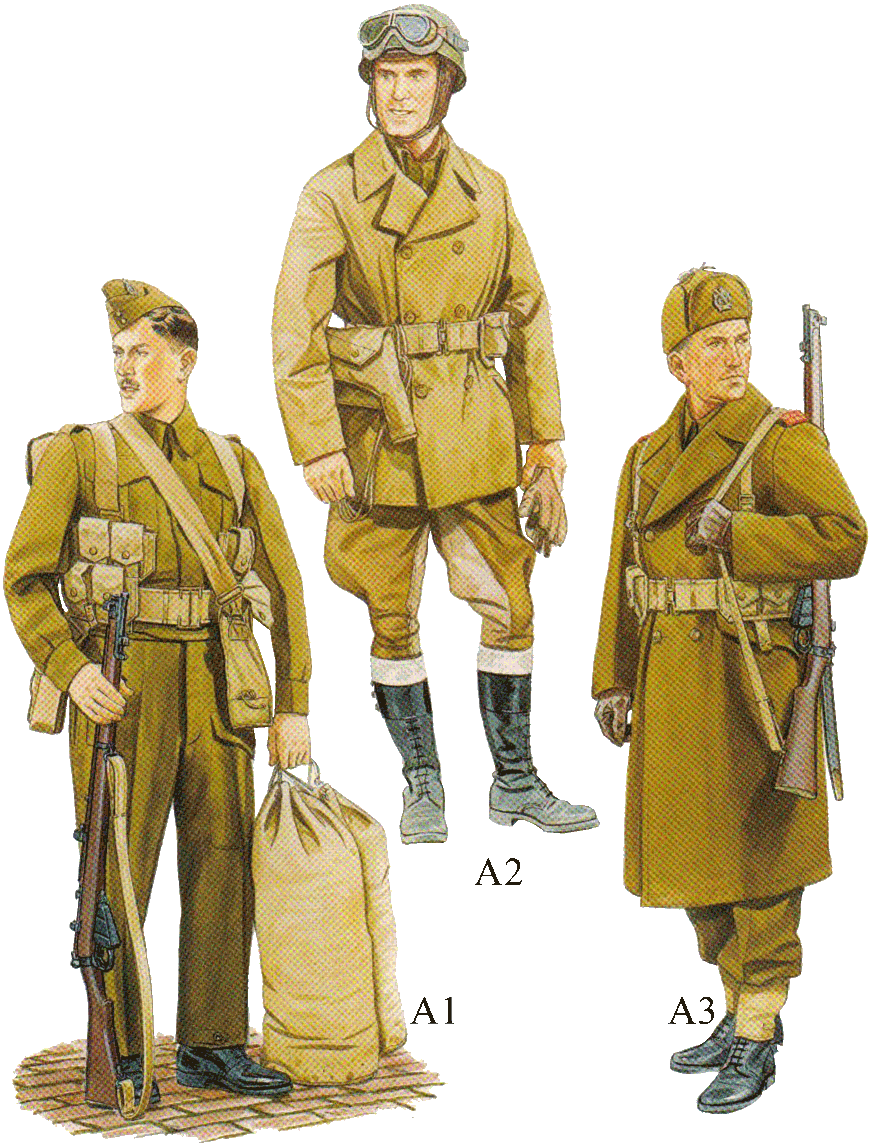
A1: Private, Princess Patricia's Canadian Light Infantry; 1st Canadian Division, UK, December 1939
The men of the 1st Division sent to Britain had the new British 37 pattern Battledress and Field Service caps made in Canada, but lacked the web anklets. The accoutrements were much older: the Regulars had, in theory, the WE 25 set, but some seem to have received the WE 08 set like the volunteer regiments. All had the old Mk I steel helmet. The 'Princess Pats' served in the 2nd Inf Bde with the Seaforth Highlanders of Canada and the (Loyal) Edmonton Regiment. Only the cap badge identifies the unit at this date, and no 'CANADA' shoulder title is yet worn.
A2: Private, Veterans' Guard of Canada; winter dress, 1940-45
The uniforms of the veterans were the same as the Regulars: khaki BD with FS caps in summer, with the addition of this khaki greatcoat and cold weather cap in winter; WE 08 or WE 37 accoutrements; and, often, the old .303in. Canadian Ross rifle in place of the Short Magazine Lee-Enfield (SMLE). From February 1941 red badges with 'Veterans Guard' in yellow were issued for wear on the shoulder straps of BD and greatcoats. Early in the war some older pre-war kit was used. Photos taken in Canada during 1941 show the pre-1939 light khaki tropical service uniform with five brass buttons, the American tropical helmet and WE 08 accoutrements. The figure shown has 4 x 10-round cartridge carriers rather than the universal pouch. The supply situation soon improved - by 1945 No. 22 Company even had a pipe band, wearing light khaki summer doublet, shirt and tie, dark kilt (probably Black Watch sett), black sporran with two white tails, Glengarry with a plain band, and white gaiters with dark hose tops. (F.H. Wooding, The Veterans' Guard of Canada', The Legionary, January 1941 & February 1947; photos in private collection)
A3: Despatch rider, Royal Canadian Dragoons (1st Armoured Car Regiment); Italy, 1943
Canadian Army motorcycle despatch riders wore, like their British counterparts, a rubberised coat (the short pattern is shown here), breeches and high three-buckle boots, and were armed with WE 37 revolver equipment. Motorcyclists had a rimless steel helmet similar to the British armoured troops' pattern but with its own liner and strapping; Trooper Everett Walter Paisley, on whom this figure is based, recalled getting the first model helmet in 1943. The RCDs provided the armoured car reconnaissance regiment for I Canadian Corps; despatch riders had a high casualty rate, and Paisley was badly wounded at Ortona just before Christmas 1943. He went on to serve in the South Alberta Regt, the recce unit of 4th Armd Div, in NW Europe, and later volunteered for the Pacific.
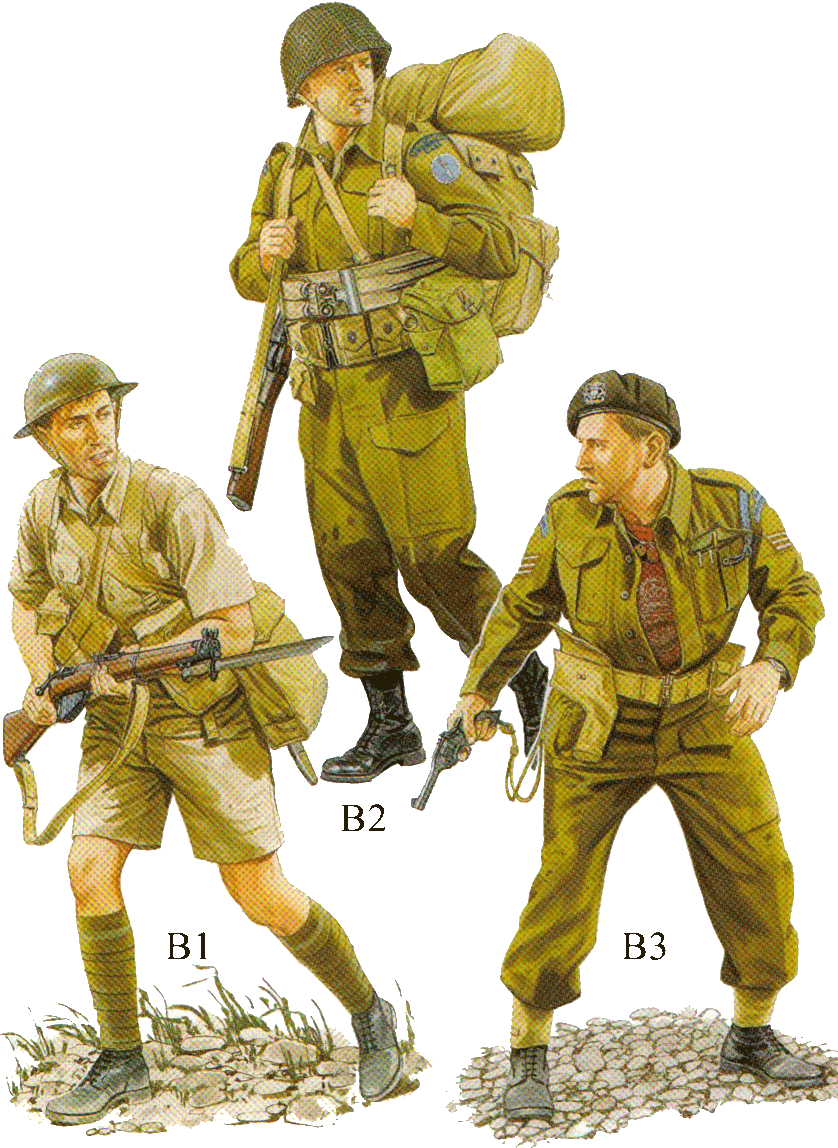
B1: Private, Royal Rifles of Canada or Winnipeg Grenadiers; Hong Kong, December 1941
No visible insignia distinguished the battle order of the two regiments which took part in the doomed defence of Hong Kong; both wore Canadian khaki drill tropical uniform. The Canadian shorts had no field dressing pocket and were cut closer than the British Army pattern. Armament and accoutrements are the conventional SMLE rifle with bayonet and WE 37 equipment. Respirators were worn slung under the left arm.
B2: Private, Régiment de Hull, 13th Infantry Brigade; Kiska, Aleutians, 1943
We have much more interesting information on this site.
Click MENU to check it out!
∎ cartalana.com© 2009-2025 ∎ mailto: cartalana@cartalana.com